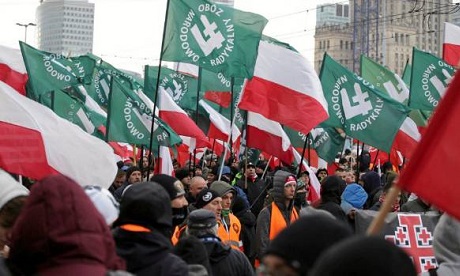About 60,000 fascists and white supremacists marched in Warsaw on Saturday, which was Poland’s Independence Day.
Although many protesters were young men, families and older people also took part in the rally. They included “neo-pagans” and Catholic groups.
Others included extremists from Sweden, Hungary, Slovakia and far-right leaders like Tommy Robinson from Britain and Roberto Fiore from Italy.
American white supremacist Richard Spencer was scheduled to speak at a conference in Warsaw on Friday, but was denied entry when the Polish government said he wasn’t welcome in the country.
Banners shouting out the protesters’ views included statements like: “White Europe of brotherly nations.”
Many protesters carried the Polish flag. Others carried banners depicting a falanga, a far-right 1930’s symbol.
Speakers talked of standing against liberals and defending Christian values, using “We Want God” as their slogan.
The slogan comes from an old Polish hymn President Donald Trump quoted in July when he visited Warsaw.
At that time Trump praised Poland for what he described as the country’s defence of Western civilisation.
The organisers of the rally’s xenophobic and far-right participants included the National-Radical Camp, the National Movement and the All Polish Youth.
These organisations’ roots were evident in anti-Semitic groups active before World War II.
The demonstration overshadowed official state observances and other patriotic events. It was the largest Polish Independence Day event in recent years.
Many of Poland’s 37.95 million (2016) citizens oppose the fascist movement.
Rafal Pankowski, head of the anti-extremist association Never Again, says despite the reference to God, the march shouldn’t be viewed as inspired by religious beliefs.
“We know that Donald Trump is not the most religious man, and I think that most of the organisers are not very religious either.
“But they use Christianity as a kind of identity marker, which is mostly about being anti-Islam now.”
State broadcaster TVP, which reflects the conservative government’s line, called the demonstration a “great march of patriots.”
It described the event as one that drew mostly “regular” Poles expressing their love of Poland, not extremists.
“It was a beautiful sight,” Interior Minister Mariusz Blaszczak said. “We are proud that so many Poles have decided to take part in a celebration connected to the Independence Day holiday.”
Source
